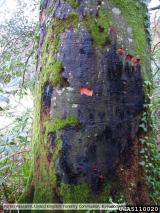Disease
A new Phytophthora species was isolated from diseased rhododendrons and European beech in Cornwall, UK in 2003. Initially called ‘Phytophthora taxon C’ or ‘P. kernovii’, it was later named P. kernoviae (etymology: ‘Kernow’, the old name for Cornwall). It causes stem lesions on members of Fagaceae, and leaf lesions and dieback on plants in several families. Hosts include Rhododendron ponticum, an understory species on which it sporulates. It is believed to be an introduced pathogen in the UK. In 2006, P. kernoviae was reported from an abandoned orchard in the Northland region of New Zealand on rotting fruit of custard apple Annona cherimola (Braithwaite et al, 2007). It appears to match earlier soil isolates recovered in New Zealand from a radiata pine plantation and native kauri forest, but appears to be more pathogenic to exotic plants than on native New Zealand flora (Garner et al. 2015). P. kernoviae was recovered from necrotic leaf litter of Drimys winteri and streams in a native forest in Chile (Sanfuentes et al. 2016, Jung et al. 2018) leading to speculation that it could have Gondwanan origins.
P. kernoviae has been found mainly on rhododendron in woodlands of southwest England with a few sites in northern England, Wales and Scotland, and Ireland. Between 2002 and 2008, 66 outbreaks occurred in managed and unmanaged land, and 5 outbreaks occurred in nurseries and garden centers in England and Wales (Walters et al. 2010). The pathogen produces abundant sporangia on leaves of Rhododendron ponticum that serve as primary inoculum for tree infections, so management efforts have focused on removal of this invasive species. Recent findings indicate that P. kernoviae can persist as oospores in rhododendron roots, complicating this management strategy (Fichtner et al. 2011). In 2009, P. kernoviae was reported on Vaccinium myrtilllus in three heathland locations in Cornwall (Beales et al. 2009) and later on the Isle of Arran (Scotland). The pathogen sporulates profusely on leaves. It is postulated that long distance disease spread may occur when coastal winds carry infected, abscised leaves. Local spread may occur via infected roots and rhizomes (Fichtner et al. 2010). Other heathland species including Vaccinium vitis-idaea and Arctostaphylos uva-ursi appear to be highly susceptible in artificial inoculation tests, suggesting that this valuable botanical resource could be endangered (Beales et al. 2009).
In the UK and Ireland, P. kernoviae causes a serious disease on European beech (Fagus sylvatica). Most of the infestations are associated with the invasive understory plant, Rhododendron ponticum, widely distributed in woodlands and gardens. The pathogen’s host range includes Chilean hazelnut, tulip tree, Gevuina avellana, Winter’s bark, Magnolia spp., Pieris spp., Michelia dolsopa, Holm oak, English oak, cherry laurel, ivy, and variegated holly. Bilberry (Vaccinium myrtillus) is an important heathland species has become infected under natural conditions (Beales et al. 2009). Nursery infestations have occurred rarely and were eradicated. Like P. ramorum, P. kernoviae causes bleeding stem cankers on members of the Fagaceae and foliar blight and shoot dieback on other hosts.
P. kernoviae seems to have been first observed by Newhook in New Zealand in 1953 (Ramsfield et al. 2009). The pathogen was associated with diseased leaves, shoots, and fruits of cherimoya trees that were near native shrublands and forest in Northland (Braithwaite et al. 2007). Previous isolates from soil in kauri forests 50 km away were not associated with disease, nor were isolates from Pinus radiata plantations near Tokoroa, 400 km to the south (Ramsfield et al. 2009). However, P. kernoviae was isolated infrequently from Pinus radiata with symptoms of red needle cast disease from several regions of New Zealand (Dick et al., 2014). The pathogen was recovered from symptomatic native vegetation only once, on Prumnopitys ferruginea (miro) (Gardner et al. 2015).
P. kernoviae was recovered from fallen necrotic leaves of native Drimys winteri (Winter’s bark), leaf litter, and streams in native forests and eucalyptus plantations in Validivia, Chile (Sanfuentes et al. 2016; Jung et al. 2018).
Table 1. Some of the most important hosts for Phytophthora kernoviae.
| Host Latin Name | Host Common Name | Symptoms | Habitat | Region | |
|---|---|---|---|---|---|
| Annona cherimola | Custard apple | Dieback, Fruit rot | Agricultural setting | New Zealand | |
| Drimys winteri | Winter's bark | Leaf necrosis | Forest | Chile | |
| Drimys winteri | Winter's bark | Dieback, Leaf necrosis | Gardens | England | |
| Fagus sylvatica | European Beech | Canker | Forest, Gardens, Parklands | England, Wales | |
| Gevuina avellana | Chilean hazel | Dieback, Leaf necrosis | Gardens | England | |
| Hedera helix | Common ivy | Dieback, Leaf necrosis | Gardens | England | |
| Host unknown | None, found in streams or soil | None, found in streams or soil | Forest, Plantations | Chile, New Zealand | |
| Ilex aquilfolium | English holly | Decline, Leaf necrosis | Gardens | England | |
| Liriodendron tulipifera | Tulip tree | Dieback, Leaf necrosis | Gardens | England | |
| Magnolia spp. | Magnolia | Dieback, Leaf necrosis | Gardens | England | |
| Michelia doltsopa | Sweet michelia | Dieback, Leaf necrosis | Gardens | England | |
| Pieris formosa | Chinese pieris | Dieback, Leaf necrosis | Gardens | England | |
| Pinus radiata | Radiata pine | Needle cast | Plantations | New Zealand | |
| Prumnopitys ferruginea | Miro | Leaf necrosis | Forest | New Zealand | |
| Prunus laurocerasus | Cherry laurel | Dieback, Leaf necrosis | Gardens | England | |
| Quercus ilex | Holm oak, Oak | Dieback, Leaf necrosis | Gardens | England | |
| Quercus robur | English oak, Oak | Dieback, Leaf necrosis | Gardens | England | |
| Rhododendron ponticum | Pontic rhododendron | Blight, Decline, Wilting | Forest, Gardens, Parklands | England, Ireland, Scotland, Wales | |
| Vaccinium myrtillus | Bilberry | Dieback, Leaf necrosis | Wildland | England, Scotland |




